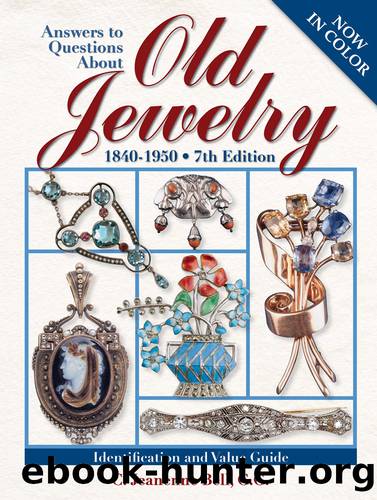Answers to Questions About Old Jewelry by C. Jeanenne Bell

Author:C. Jeanenne Bell
Language: eng
Format: epub
Tags: epub, ebook
Publisher: Penguin Publishing Group
Published: 2008-08-14T16:00:00+00:00
As you can see in the 1936–37 Sears Catalog, the lady on the left is wearing Bakelite jewelry, which was included with the dress. The dress of the lady on the right came with rhinestone jewelry also included in the price.
The biggest influence on fashion in the '30s was Hollywood. People escaped their problems for a few hours by going to the movies. There they were exposed to the newest in fashion, bigger than life on the silver screen. In 1933, Adrian, a fashion designer for Hollywood, stated, “Motion Pictures are becoming the Paris of America. There, when women see the stars in pictures, they can see them as their fashion guides.”2
Clothing retailers were quick to realize the tremendous influence that the stars had on American women. The 1931–32 Montgomery Ward Catalog featured “styles worn at Hollywood First Nights.”Next to their lovely “Sun Down frock of luxurious silk canton crepe with graceful shoulder bows of transparent velvet” ($4.74), was a picture of Claudette Colbert, “exotic Paramount star,” and an invitation to see her in her newest film “Death Takes a Holiday.” With coats advertised to be Hollywood's' favorite was a picture of Helen Twelvetrees, also a Paramount star. Another advertisement assured that, “Hollywood favors smartly tailored sports coats.” It featured Marlene Dietrich as “Paramount Pictures tailored queen. See her in ‘Song of Songs.’”
The 1935–36 Sears Roebuck Catalog featured “autograph fashions worn in Hollywood by the stars.” The advertisement for a “lovely smocked dress ($3.98)” claimed to be “a fashion in the wardrobe of the exquisite Hollywood star, Adrienne Ames. Each dress bears her autograph label.” In the section that advertised collars, stars such as Ann Southern and Marion Nixon were shown wearing their “autograph fashions.” The hat section pictured six hats ($1.69-$1.98) modeled by their namesake stars. Who could resist the urge to buy one after seeing now smart it looked on the star?
Movie fashions became big business. An article about the Modern Merchandising Bureau in New York City appeared in the January 1937 issue of Fortune Magazine. It explained that:
The work of the bureau consists of providing retail shops with models of hats and dresses worn by the stars of current films, but it is a good deal more complicated than it sounds. First of all, the bureau has to study the stills of coming attractions and figure out what styles are going to be popular. Then it has to arrange with a manufacturer to have them made up before the picture is released. And finally it has to supply retail shops with advertising that mentions the movie from which the model was taken and the theater at which it is playing.
In April of 1937, National Business published “A 12,000 Mile Style Parade,” by Edgar Lloyd Hampton. He commented on the fact that Hollywood was the “world's style capital” and that young American designers were creating movie fashions that were changing the clothing habits of the nation:
First on the list we might mention the sex dress (that close fitting gown which caused so many automobile accidents back around 1930.
Download
This site does not store any files on its server. We only index and link to content provided by other sites. Please contact the content providers to delete copyright contents if any and email us, we'll remove relevant links or contents immediately.
Periodization Training for Sports by Tudor Bompa(7327)
The MacArthur Bible Commentary by John MacArthur(4236)
The Body: A Guide for Occupants by Bill Bryson(3797)
The Sports Rules Book by Human Kinetics(3585)
What It Really Takes to Get Into Ivy League and Other Highly Selective Colleges by Hughes Chuck(3220)
Marijuana Grower's Handbook by Ed Rosenthal(3115)
The Sprouting Book by Ann Wigmore(3052)
Salt, Fat, Acid, Heat: Mastering the Elements of Good Cooking by Nosrat Samin(2658)
The Martian by Andy Weir(2607)
Classic by Mary Berry(2501)
The Bread Bible by Rose Levy Beranbaum(2469)
Harry Potter 4 - Harry Potter and The Goblet of Fire by J.K.Rowling(2416)
Sapiens and Homo Deus by Yuval Noah Harari(2410)
The Marketing Plan Handbook: Develop Big-Picture Marketing Plans for Pennies on the Dollar by Robert W. Bly(2410)
Martha Stewart's Baking Handbook by Martha Stewart(2330)
50 Economics Classics by Tom Butler-Bowdon(2065)
Screenplay: The Foundations of Screenwriting by Syd Field(2056)
The Cambridge Grammar Of The English Language by Rodney Huddleston Geoffrey K. Pullum(2045)
The Plant Paradox by Dr. Steven R. Gundry M.D(2038)
